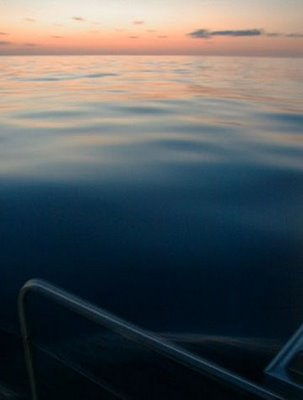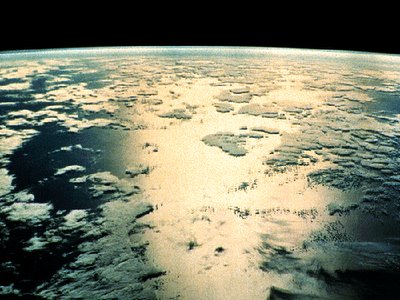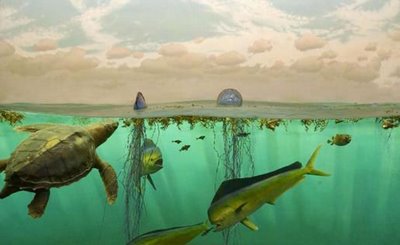Sargasso Sunrise

How the flukes splash!
How they contort rapid as lightning, with spasms and spouts of blood!
Be at peace bloody flukes of doubters and sullen mpoers,
I take my place among you as much as any;
The past is the push of you and me and all precisely the same,
And the night is for you and me and all,
And what is yet untried and afterward is for you and me and all.
I do not know what is untried and afterward,
But I know it is sure and alive, and sufficient.
-- Walt Whitman
HEAVEN IS (NOT HERE)
St. Brendan and his companions come to a very high inaccessible island and cannot find an entrance. Having circled the island for a number of days, they see a church, and hear the voices of people singing and praising God. A waxen tablet is lowered to them, bidding them to cease trying to enter the island, that they will find the island which they seek, but that they must return home as their own people wish to see them; this is not the promised land (“non ista tibi terra promissa”). They leave the island, taking with them the tablet, which they used to read every day as if it had been sent to them by God.”
***
SARGASSO
Rains finally after weeks and
Weeks, that hard blue-maned
Coursing sky now a thick black
Loam humming and sweet
At 4 a.m. Jasmine blooming
On the chimney like a thousand
White mouths of honey. Profusion
Clogs the tide though not far
Beneath there’s nothing but sand
And cold water for miles.
The visible part of this poem
Winnows its hair in the garden,
Dreaming sated of the rain
Which fell far into the night.
But so much of it drifts far under
Like the ghost keel of fallen titan,
His penis swirling in dark swale
Like a slowly dying, diving whale.

Sargasso:
The central oceanic regions, bounded by the currents that sweep around the ocean basins, are in general the deserts of the sea. There are few birds and few surface-feeding fishes, and indeed there is little surface plankton to attract them. The life of these regions is largely confined to deep water. The Sargasso Sea is an exception, not matched in the anticyclonic centers of other basins. It is so different from any other place on earth that it may well be considered a definite geographic region. A line drawn from the mouth of Chesapeake Bay to Gibraltar would skirt its northern border; another from Haiti to Dakar would mark its southern boundary. It lies all about Bermuda and extends more than halfway across the Atlantic, its entire are being roughly as large as the United States. The Sargasso, with all its legendary terrors for sailing ships, is a creation of the great currents of the North Atlantic that encircle it and bring into it the millions of tons of floating sargassum weed from which the place derives its name, and all the weird assemblage of animals that live in the weed.
The Sargasso is a place forgotten by the winds, deserted by the strong flow of waters that girdle it as with a river. Under the seldom-clouded skies, its waters grow warm and heavy with salt. Separated widely from coastal rivers and from polar ice, there is no inflow of fresh water to dilute its saltiness; the only influx is of saline water from adjacent currents, especially from the Gulf Stream or North Atlantic Current as it crosses from America to Europe. And with the little, inflowing streams of surface water come the plants and animals that for months or years have drifted in the Gulf Stream.
The sargassum week is a brown alga that lives attached to rocks along the coasts of the West Indies and Florida. Many of the plants are torn away by storms, especially during the hurricane season. They are picked up by the Gulf Stream and are drifted northward. With the weeds go, as involuntary passengers, many small fishes, crabs, shrimps, and innumerable larvae of assorted species of marine creatures, whose home had been the coastal banks of sargassum weed,.
Curious things happen to the animals that have ridden on the sargassum weed into a new home. Once they lived on a rocky shore, a few feet or a few fathoms below the surface, but never far above a rocky bottom. They knew the rhythmic movements of waves and tides. They could leave the shelter of the weeds at will and creep or swim about over the bottom in search of food. Now, in the middle of the ocean, they are in a new world. The bottom lies two or three miles below them.Those who are poor swimmers must cling to the weed, which now represents a life raft, supporting them above the abyss. Over the ages since their ancestors came here, some species have developed special organs of attachment, either for themselves or for their eggs, so that they may not sink into the cold, dark water far below. ...
It may have taken eons of time to accumulate the present enormous quantities of weed, which Parr estimates as about 10 million tons. But this, of course, is distributed over so large an area that most of the Sargasso is open water. The dense fields of weeds waiting to entrap a vessel never existed except in the imaginations of sailors, and the gloomy hulks of vessels doomed to endless drifting in the clinging weed are only the ghosts of things that never were.
-- Rachel Carson, The Sea Around Us


<< Home